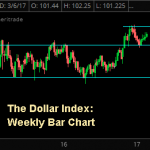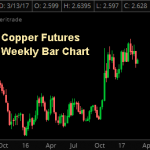“Just Right” Jobs Report & This Week’s Numbers. March 13, 2017
This is an excerpt from today’s Sevens Report. Sign up for your free trial for clear, easy-to-digest information on stocks, bonds, commodities, currencies, and economic data, in your inbox by 7am each morning.
Last Week:
The only material economic report last week was the jobs report, and it confirmed that the Fed will hike rates this Wednesday. Internationally, the ECB was very slightly hawkish in tone, although it has no plans to further curtail its QE program. As such, the hawkish tone was taken more as an endorsement of accelerating growth and inflation momentum, and European stocks (HEDJ) rallied on the news.
Looking at the jobs report, it was at the higher end of our “Just Right” range, and as such it confirmed a coming rate hike this Wednesday… but it wasn’t so strong that it would cause the Fed or the market to consider four hikes in 2017.
The headline jobs number was a solid beat at 253k vs. (E) 195k, and revisions to January and December were positive by 9k. The unemployment rate dropped to 4.7% vs. (E) 4.8%, but that also came on lower labor participation (so it’s not a fully virtuous drop). However, U-6, which is the better measure of employment as it counts underemployment, fell to 9.2% from 9.4%—matching a multi-year low it set back in December. Point being, we can quibble over the 4.7% unemployment rate, but in total, measures of the jobs market are signaling the economy is at full employment. Wages also rose 0.2% in February vs. (E) 0.3%, and the y-o-y gain increased slightly to 2.8%, or just below our “Too Hot” mark of 2.9%.
Bottom line, it was a Goldilocks report (the second in a row), and stocks rightly rallied, as again it signaled a very strong jobs market (at least in terms of employment) and rising wages. Still, none of the numbers were so high that it should make the Fed materially more hawkish. Bigger picture, economic data continues to broadly sup-port the markets while the policy outlook in Washington grows more dim seemingly each week. The new variable is the Fed, however, and if rates rise too fast in 2017 (which we think they might) that could increase the risk to stocks. For the first time in 11 years, the pace of rate increases is an important variable for stocks.
Looking internationally, the ECB was very slightly hawkish in tone during last week’s meeting, but that’s only because the ECB cited improvement in growth and inflation data (both of which were stock positive). So, in some ways the ECB finds itself in a similar position to the Fed several years ago (late- 2014/early 2015) when it was winding down QE very gradually into a slowly accelerating economy. That environment is positive for stocks, so despite reports of the ECB turning more hawkish, policy will remain accommodative for a very long time, and we remain bullish European stocks.
This Week:
Wednesday is the most important day this week, as we not only get the FOMC decision, but there also will be very important releases on inflation and growth. Again, the critical context for all of this is whether the Fed and the data point to more than three hikes in 2017, a situation that is not priced into stocks, the dollar or yields.
Starting first with the FOMC meeting, we will give our “FOMC Preview” in tomorrow’s subscriber version of the Sevens Report, but while a 25-basis-point rate hike is widely expected, the real key to this meeting is whether the FOMC increases the number of expected rate hikes (i.e. the “dots”) to four from three. That’s the hawkish variable to watch for Wednesday, because that could hit stocks and bonds.

Consumer spending remains the biggest driver of economic growth, and that needs to continue if we’re to see a broad acceleration.
In addition to the Fed decision Wednesday, we get two important February economic numbers: CPI and Retail Sales. CPI has been slowly creeping higher, and if that continues it will increase the chances of four rate hikes this year (regardless of what the FOMC says). Meanwhile, after big growth in Q3/Q4 2016, retail sales have cooled in 2017, and a resumption of that uptrend will be welcomed by stocks (strong economic data is needed to support this market in the face of a growing mess in Washington and higher rates). Consumer spending remains the biggest driver of economic growth, and that needs to continue if we’re to see a broad acceleration.
Finally, I’ll talk more about this in tomorrow’s full edition of the Sevens Report, but there has been a growing gulf between economic data that’s based on surveys (i.e. the PMIs) and actual, hard data. People in the media are calling it “soft vs. hard” economic data, but here’s the issue. While survey data has been surging to multi-year highs, actual economic data really isn’t moving that much. That’s a potential problem for obvious reasons. Actual hard data—retail sales and industrial production (out Friday), need to start to match this survey data, otherwise that gap will widen.
Take advantage of the limited time special offer to new subscribers—if you subscribe to the Sevens Report today, and after the first two weeks you are not completely satisfied, we will refund your first quarterly payment, in full, no questions asked.


